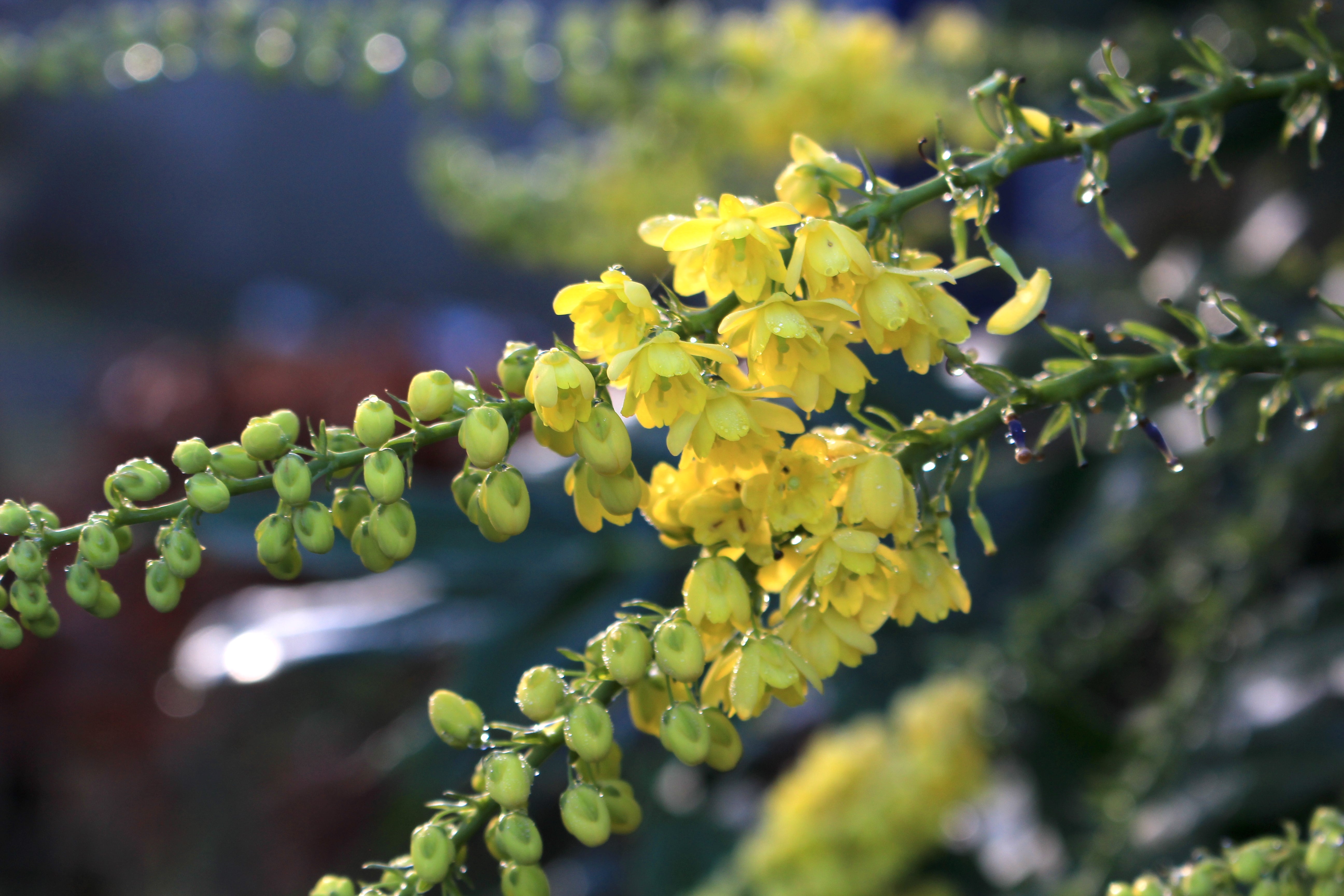Mahonia x media 'Charity'
Approx. 0.5 litre pot
About this cultivar:
Mahonia x media 'Charity' is an upright evergreen shrub, with deep, dark, handsome, holly-like pinnate leaves composed of lance-shaped leaflets. In late autumn and winter, above the foliage, lots and lots of small, cup-shaped yellow flowers are borne in erect, clustered terminal racemes. The effect is quite strikingly architectural, but also... flower-y.....is there a better word? Nope, flowery, that's the effect. Something flowery should look a bit strange in winter but this somehow doesn't.
I've read the pollen is good for insects in the winter, but, quite frankly I have never seen an insect near them. Perhaps our winter is too cold and the bees etc are on holidays in Barbados or somewhere.
The hybrid, Mahonia x media, is a a popular garden plant with parents Mahonia oiwakensis subsp. lomariifolia and Mahonia japonica. The result is a tough, hardy, reliable plant with scented flowers that will grow almost anywhere. The first recorded plant of this cross was found in a mixed batch of seedlings from Mahonia oiwakensis subsp. lomariifolia that was raised in the Slieve Donard Nursery, Northern Ireland, in 1951 or earlier. One of these plants made their way to England and was given the cultivar name ‘Charity’ (this cultivar!) at the Savill Gardens, England, where it first flowered. The owner of Slieve Donard nursery, Lesley Slinger, eventually introduced 'Winter Sun' which, compared to 'Charity' is slightly smaller and has slightly earlier, slightly brighter, slightly more fragrant, flowers.
In a 1993 book, 'Glory of Donard': A History of the Slieve Donard Nursery, Newcastle, County Down, Lesley Slinger is quoted
'I think it would be well to shed some light on the rather odd choice of name for the new Mahonia. I cannot think that many people, and certainly not me, will admire it. Yet there is a reason. When my friend, who had acquired the original seedling, first had proof of his foresight and ability to pick a winner, he began to investigate the origin of the seedlings and, of course, he traced them back to me. When he heard my story, his sympathy and compassion was expressed in his proposal of ‘Charity’ as the name of the plant'
- Position: Full sun, partial shade, almost full shade but won't flower so well
- Soil: Almost any soil, grows well in Ballyrobert
- Flowers: November, December, January, February, March
- Other features: Grows well in Ballyrobert
- Hardiness: H5 - Hardy in most places throughout the UK even in severe winters (-15 to -10°C), Fully hardy, grows well in Ballyrobert
- Habit: Bushy
- Foliage: Evergreen
- Height: 250 - 400cm (8 - 13 ft)
- Spread: 250 - 400 cm (8 - 13 ft)
- Time to full growth: 10 to 20 years
- Plant type: Shrub
- Colour: Green, yellow
- Goes well with: -
About this genus:
Mahonia is a genus of approximately 70 species of evergreen shrubs and, rarely, small trees in the Barberry family (Berberidaceae), native to eastern Asia, North and Central America. The genus name, Mahonia, derives from Irishman Bernard McMahon, who was involved in plant collecting with the 1803-1806 Lewis and Clark expedition across the USA. Maybe we should call it McMahonia?
They are closely related to the genus Berberis and some botanists disagree on whether to recognize a separate Mahonia genus since several species in both genera are able to hybridize, and because the only morphological difference seems to be leaf pinnation. However, recent DNA-based studies retain the two separate genera.
Mahonia species bear pinnate leaves with 3 to 15 leaflets, that are often spiky to touch and in appearance. The flowers are borne in terminal clusters or spreading racemes, and may be among the earliest flowers to appear in the growing season. Several species are popular garden shrubs, grown for their ornamental, often spiny, evergreen foliage, yellow flowers in winter and blue-black berries in autumn. Wild life seem to love the berries. It should be noted some rare species or hybrids can flower in autumn or spring and sometimes with reddish flowers.
Commonly called Oregon grape, the ripened fruits are said to be acidic with a very sharp flavour. Some Native American tribes used to eat the fruit from some species. However, don’t eat any you may see, leave them to the birds! Most species around these days contain berberine, a compound found in many Berberis and Mahonia which can cause vomiting, lowered blood pressure, reduced heart rate, lethargy, and other ill effects when consumed.
Most Mahonia will grow almost anywhere that isn’t a swamp. In the garden they can be taken for granted because they are seen as quite popular, common, or perhaps even car-parky plants. But don’t let that put you off, they are popular for a reason!
Pragmatic and beautiful, Mahonia are often used for filling an empty or difficult spot at the back of a border, on in a spikey defensive Maginot-hedge. This is because they easily produce sharp glossy evergreen foliage with reliably beautiful flowers at a time of year when the rest of the garden can be struggling. However, note, we don’t grow ours in a hedge or the back of the border but pride of place in a flower bed, so they stand out and show off! Though, if you own a car park feel free to buy them from us too.




































